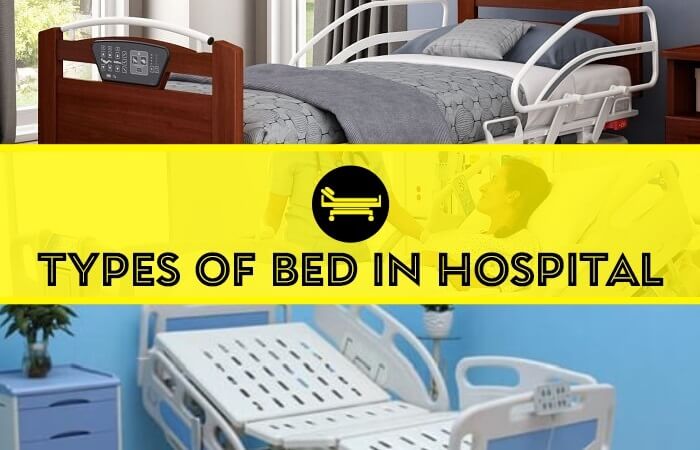Hospital beds are carefully designed to provide the patients with a wholesome recovery and healing environment while paying great attention to their comfort, stability, as well as safety. However, whereas, one kind of bed might perfectly fulfill the requirements of a particular user; some specific patients mat need a different type of hospital bed.
Basically, different hospital beds might be better suited for different purposes. Therefore, to help you understand the different types, styles of beds that are available in the market, we have curated below, detailed information about all the different kinds of Hospital Beds. Apart from that, the information mentioned below will also help you understand the anatomy of a specialized hospital bed in a better way.
A. Hospital Beds based on their Functioning & Source of Power:
B. Hospital Beds designed for Specific Purposes:
C. Important Features of a Hospital Bed:
A. Hospital Beds based on their Functioning & Source of Power:
1. Manual Beds
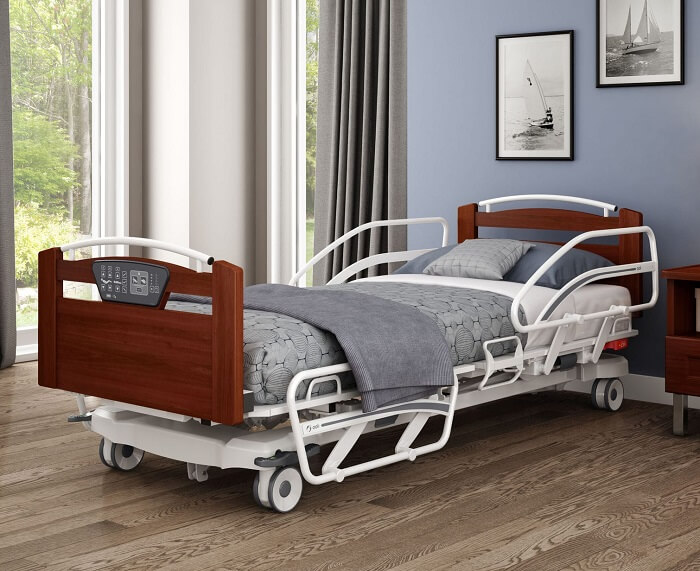
A bed that does not has the capability of adjustments through electrical means is termed a Manual Hospital Bed. These types of beds usually have a manual hand crack which can be used to adjust the positions of the beds. The hand crank is usually situated near the foot or the head of the bed.
Pros:
-
- This is one of the most economical types of hospital beds. Much cheaper than the electric ones.
Cons:
-
- Manual beds offer only limited positioning options. They usually offer only head or foot adjustments.
- They also lack height variations.
- If the user is not physically enabled to operate the crank, a caregiver might be required, whenever adjustments are required.
Recommended for:
-
- Users who may not need frequent position adjustments
- Check bed sheet types.
2. Semi-Electric Beds
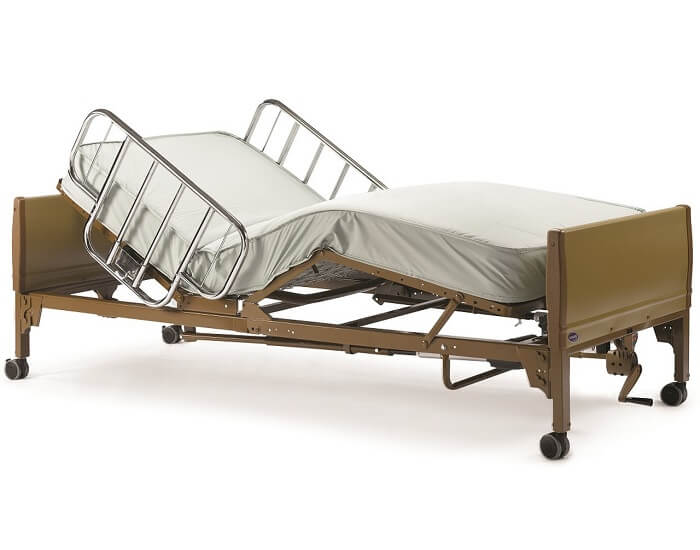
These types of beds usually offer a combination of manual and electric adjustments. Usually, the height of the beds can be adjusted manually with the help of a hand crank. However, the head and foot adjustments can be done with the touch of buttons placed near the hand of the user. Also check types of pillows.
Pros:
-
- The user can himself adjust his head and foot positioning without anybody’s help
- Perfect for people who need frequent adjustment, without paying a hefty amount for fully automatic beds
Cons:
-
- Height adjustments may need the help of a physically enabled caregiver.
Recommended for:
-
- Users who may not require frequent height adjustments but are capable enough of monitoring their head and foot adjustments by the touch of a button themselves
3. Electric Beds

Medical Facilities often use fully automatic hospital beds which can be operated with just a click of a button. In these types of beds, the head and foot adjustments, along with the height can be operated without any manual input by the user or the caregiver. Apart from that, fully automatic hospital beds also offer a few more positions/transitions which are as mentioned below.
-
- Trendelenburg position: In this position, the entire bed platform is tilted at 15-30 degrees, with the user’s feet above his/her head. This position is used to aim at blood circulation.
- Reverse Trendelenburg Position: This position is exactly the opposite of the Trendelenburg position, with the user’s head above their feet. This position is used to aid with breathing and pressure relief.
- Cardiac Chair: Patients with heart surgeries as breathing issues are believed to recover faster if they spend most of their time sitting upright. Many fully automatic beds are often designed with an integrated position of a cardiac char. With the help of this position, the patient or the caregiver can switch the bed from the flat-lying position to the cardiac chair position using the buttons present on the bed, with minimal movement of the user.
Pros:
-
- Patients can themselves change their position without the help of a caregiver
- A better pick for caregivers with weaker physical strength
Cons:
-
- Highly expensive
- Might stop operating completely due to equipment failure
Recommended For:
-
- Patients who need frequent height as well as position adjustments
B. Hospital Beds designed for Specific Purposes:
1. Bariatric Beds
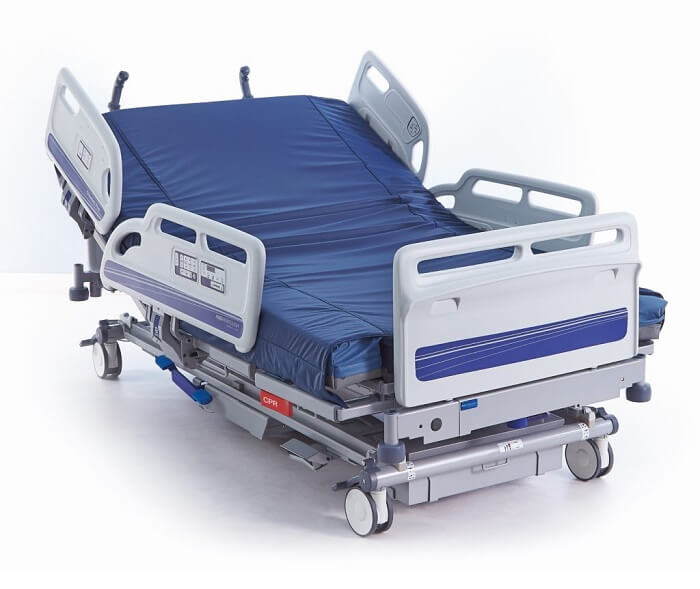
Bariatric beds are usually larger and stronger than general hospital beds. These beds comprise a larger sleeping surface and specialized mattresses to accommodate bariatric patients. These heavy-duty beds can accommodate users weighing up to 1200 pounds and can measure up to 54” x 88”.
2. Low Beds
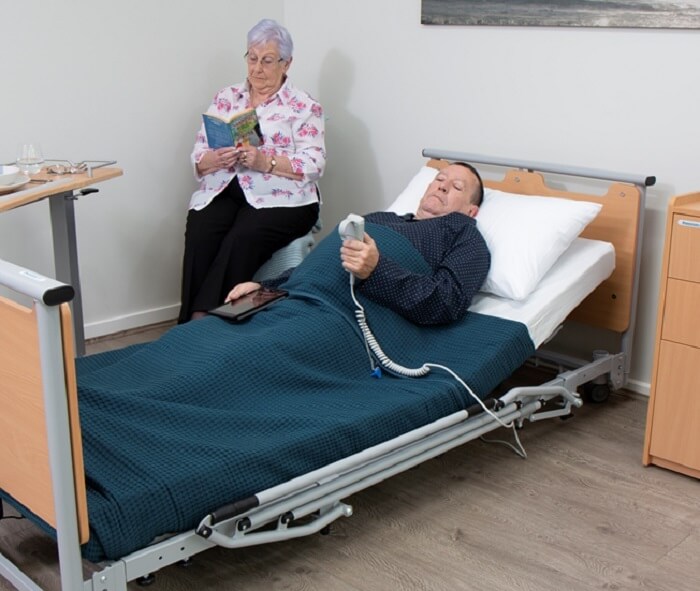
Low beds are similar to standard hospital beds. They can be manually operated as well as fully electric. However, the only additional function is that they offer extensive height adjustments. They allow the bed platform to be lowered almost to the ground level. These beds are designed for preventing the patient/user from falling off the bed. They are specifically designed for patients with mobility constraints to get off and get on to the bed.
3. Hospital Cribs
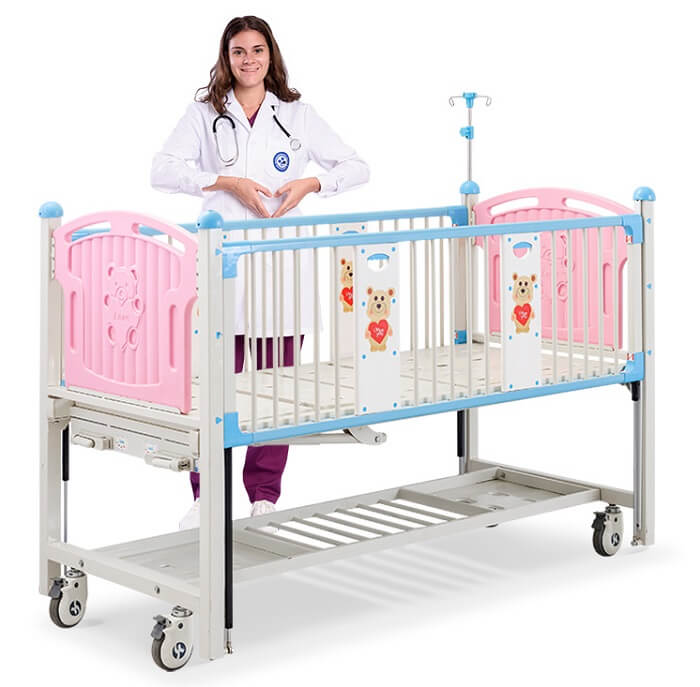
Also termed as safety beds, hospital cribs are specially used for children who may be at risk of falling out of the bed. They usually have high railings on all the sides of the beds. It prevents the child to get out of the bed himself. Basically, they are meant for the safety of children who are recovering or need medical care.
4. Gatch Beds
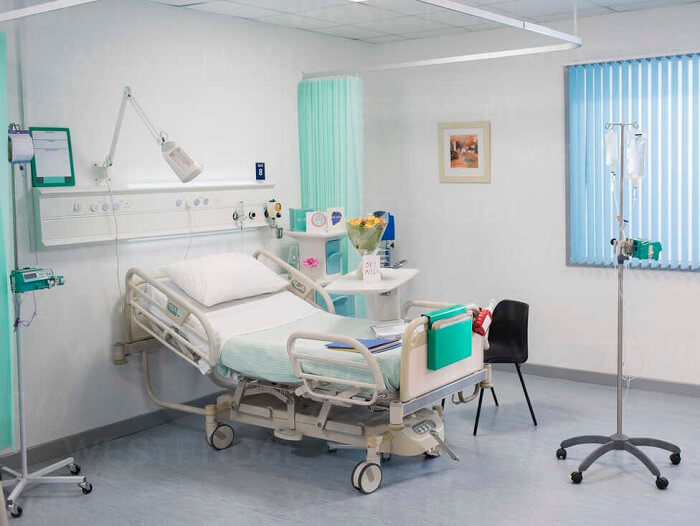
Gatch beds are usually used by medical outposts and locations that may lack funds. These are highly economical durable as well as functional medical beds. A Gatch bed generally features three adjustable sections, which are made functional with the help of a spring mechanism. The three movable sections comprise the head, knee, and foot. These beds also offer the patients to sit upright to aid with breathing. The only drawback of this kind of bed is that they may need the help of a caregiver to adjust to different positions.
5. Fluid-Air Beds

Fluidized air beds are specially used by medical care facilities for patients with wounds that are really difficult to heal. These types of beds usually distribute the weight of the patient evenly over the complete mattress. These beds provide temperature-controlled air through tiny holes to minimize the pressure on the patient’s body. They are designed to create an ideal environment for wound recovery by controlling factors like body friction, temperature, pressure, as well as moisture. These beds are meant only for specialized hospitals and cannot be used for long-term recovery or care at home.
6. Freedom Beds
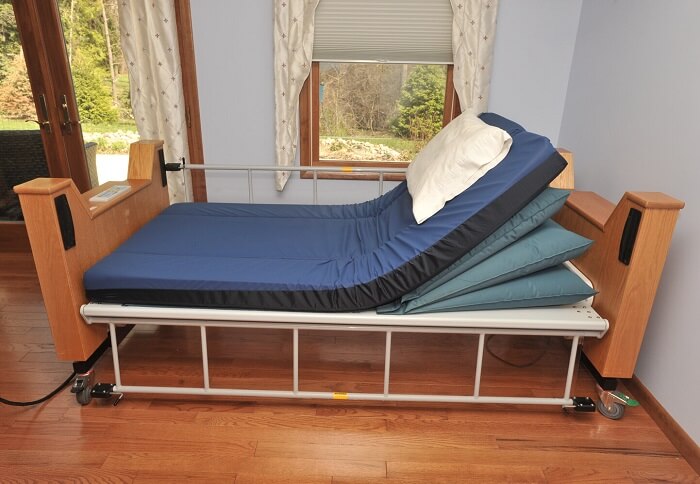
This is one of the most advanced types of hospital beds available in the market. It uses a 3-part rotation platform that can help reposition the patients in the smoothest way possible, without disturbing them. The seamless repositioning technique of a Freedom bed prevents any kind of pressure injuries to long-term bed-ridden patients. One of the unique features of Freedom Bed is its air system, which is located between the platform and the mattresses, which allows the users to be repositioned automatically even when their upper torso is in a raised position. By all means, this is one of the latest and most comfortable medical beds that one can get hold of.
C. Important Features of a Hospital Bed:
Different types of hospitals may feature different elements. Moreover, different types of patients and users may need different particular features to be integrated into their hospital beds to provide them with complete safety and comfort. Below mentioned are the various major elements of hospital beds along with their uses, which may be helpful for patients with different health issues and disabilities.
1. Positioning Options

Most of the standard hospital beds are competent enough of providing basic position adjustments, including lowering and raising your head or feet. However, if the patient requires any additional positioning options like Trendelenburg, Reverse Trendelenburg, Cardiac Chair position, or Fowler’s position, look out for special beds that offer the same.
2. Side Rails
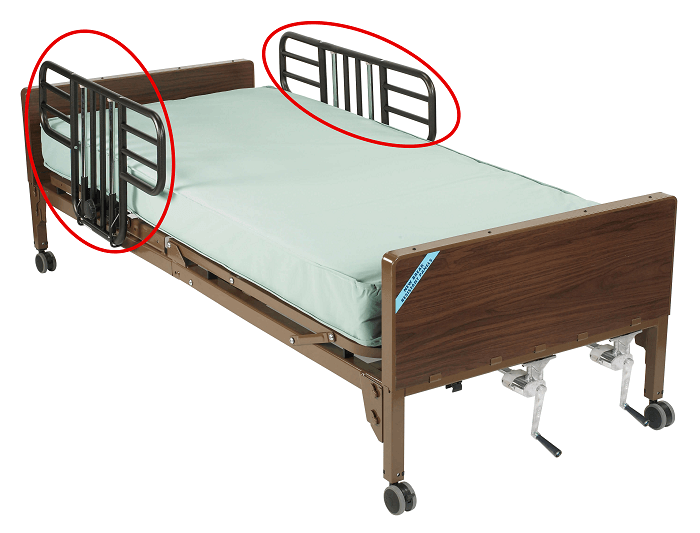
Bed Rails are hand grabs that are installed on either side of a hospital bed. Apart from providing them with support while moving in or out of the bed, the handrails also prevent the user from falling off the bed while being asleep. These rails also act as a source of providing stability to the users while transiting from one position to the other. Some beds offer full-length rails, extending down to the floor level, whereas; others may offer rails up to half-length.
3. Weigh Scale
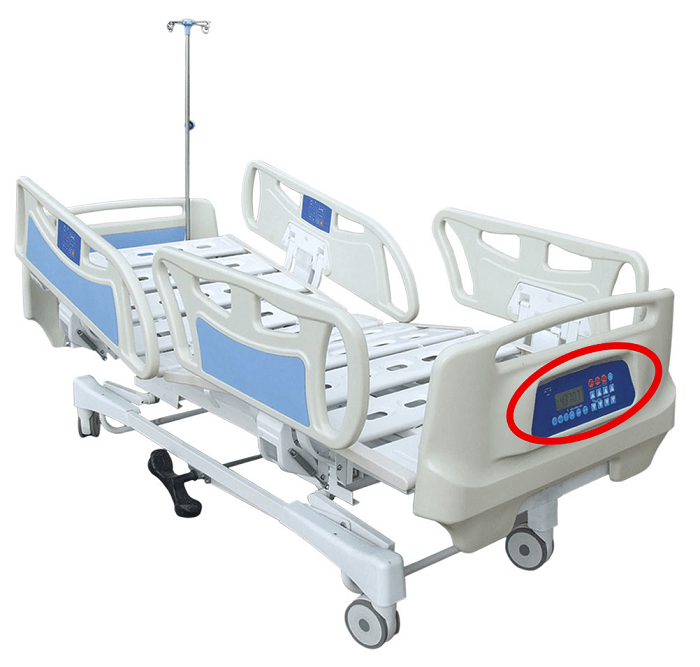
Many hospital beds come integrated with weigh scale that can help weigh the users without having them be transferred to and from the bed. These are highly effective for those patients that need to be weighed at regular intervals of time.
4. Trapeze

Trapeze usually hands over the head over the bed to provide support to the patients while repositioning them. This equipment is either integrated with the frame of the bed or also can be used as a freestanding structure if the bed does not have one. These can highly effective for those who need some support while switching positions or getting in or out of the bed.
5. Gap Protection

Gap support is one of the most important safety elements for those users who experience nocturnal movements or seizures. Most hospital beds are specially designed with efficient gap protection. However, if you are additionally providing railings or the bed does not offer bed protection, it is very important to add on the same to prevent the user or patient from getting stuck into the gap between the sides and the bed.
6. Storage Space
Most of the standard hospital beds do not offer any kind of storage space. However, a few latest models come attached with basic storage spaces. These spaces can come in really handy for the user as well as the caregiver. They can be used to store essentials like gloves, medical supplies, and other commodities like books, remotes, and magazines.
Hospital Bed Buying Guide
If you are planning to get a hospital bed installed at your home to aid your loved one’s recovery or care, you need to carefully assess the below-mentioned points to shortlist the best option for them.
Review the mobility of the user:
The very first thing that needs to be considered while searching for a hospital bed is the mobility of the user. If the user is capable enough of getting in and out of the bed themselves, is stable on their feet without any aid, and has a basic level of arm strength, using a budget-friendly yet completely functional may work. However, if they have even the slightest difficulty in maneuvering their own movement, you should go in either with a semi-automatic or automatic hospital bed.
Know the timeframe for which you may need the bed:
If the user is required to be in bed for a major part of the day or is to be bed-ridden for a long duration of time, you should simply go ahead with a fully electric hospital bed. However, if the user needs the bed only for a short period of time, you should go in with a semi-automatic or manual hospital bed, along with hiring a part-time caregiver, if required.
Choose the bed based on the size of the user:
Normal-sized patients can be easily accommodated and comfortable in a standard-sized hospital bed. However, if the user is extra-ordinarily heavy or large, they may need a heavy-duty bariatric bed to accommodate them comfortably. If the bed is to be acquired for children, you should go in with specially curated hospital cribs that may prevent them from falling off the bed and keep them safe.
Pick a bed based on the user-friendliness of the caregiver:
If the patient or user requires the attention of a caregiver and is being attended to by a family member or even a medical professional, it is important to keep in mind the strength of the caregiver. If the caregiver has the basic strength to operate a manual hand crank, you can go in for a manual hospital bed. However, if the caregiver is not physically competent, a semi-electric or electric hospital bed is good to go.
Assembly and Installation of the Bed:
Some of the beds may have really complex spare parts. If you will need the help of a professional in order to install the bed or for maintenance, ensure if the bed seller provides a quick and outstanding after-sales service. Else, search for a bed that is easy to set up as well as maintenance-free.
We surely cannot compromise with even the slightest feature of any medical equipment. Hospital beds are one of the most commonly used and one of the most helpful equipments that enhances the comfort and recovery of any given patient. We hope that the above-mentioned information will help you know the different types of hospital beds in more detail as well. Also, if you need to get a hospital bed for the use or recovery of your loved ones, the above-mentioned guide would surely turn out to be handy!
James Smith
Latest posts by James Smith (see all)
- What are the Advantages of Pimple Patch? - May 31, 2023
- Inseam Vs Outseam Measurement in Shorts - February 1, 2023
- 5 Jewelry Marketing Ideas To Attract More Customers - January 30, 2023
